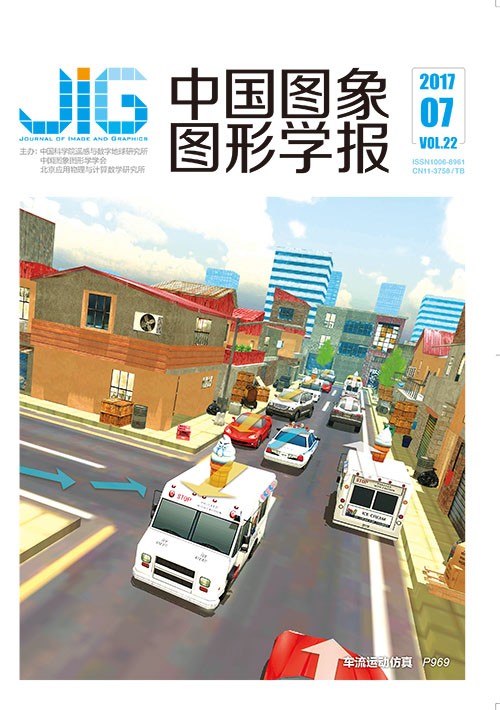
可变形网格引导的群体队形仿真
摘 要
目的 许多群体运动仿真算法侧重于模拟由大量自由移动个体所组成的群体行为,而针对具有特定队形的群体运动仿真算法较少。为解决这一问题,采用改进的网格引导方法,利用可变形网格对群体运动进行控制。方法 首先,对群体队形进行三角划分,建立一个连接所有智能体的队形网格。然后,利用障碍势场法在群体运动的过程中对队形网格进行变形,使智能体在避免与障碍物发生穿透的同时尽可能保持整体队形稳定。最后,针对障碍物穿过队形网格时可能造成的局部智能体 “错位现象”,提出了基于吸引点的网格引导方法,使群体绕过障碍物后能迅速恢复原来队形。结果 使用Unity软件对军队行进、动态车流、群体表演等场景中的智能体编队移动进行仿真,并设置了不同规模的群组交换实验进行对比。本文算法的实时计算花销主要集中在网格变形阶段:在队形网格顶点总数为1 000时,单位仿真步内网格变形阶段的平均运行时间为20.15 ms。队形网格划分阶段是一个预先进行的过程,不影响算法实时性。基于吸引点的网格引导方法提高了智能体的全局移动效率,使队形变化更加自然流畅。结论 实验结果表明,可变形网格引导的群体队形仿真算法在群体运动过程中能有效维持队形稳定,无论障碍环境是静态的还是动态的都能实现良好的群体避障,说明算法的有效性。
关键词
Deformable guiding mesh-based simulation of group formation
Li Zuning1,2, He Wu1,2(1.Visual Computing and Virtual Reality Key Laboratory of Sichuan Province, Sichuan Normal University, Chengdu 610068, China;2.College of Movie and Media, Sichuan Normal University, Chengdu 610068, China) Abstract
Objective Crowd simulation has become an increasingly popular research topic because of its potential applications in virtual reality and computer animation. Most of the existing research utilizes methods, including social force, hydrodynamic, and data-driven models, to control the movement of the groups. Social force models treat agents as independent individuals with mass and velocity and control the movement of the agents by applying external controlling force. Hydrodynamic models introduce the concept of fluid dynamics into crowd simulation, which is appropriate for simulating large-scale groups. Data-driven models extract data from videos of real crowds and enter the data into crowd simulation to obtain authentic group behavior. These methods focus on the simulation of groups, which contain a large number of free-moving agents. However, these methods cannot be applied in simulating groups that move in a specific formation, which extensively exist in social activities (e.g., a marching army or a dancing group). In group formation control, the agents are expected to move in a similar direction with similar velocity among other agents in the group while maintaining an overall formation. The major difficulty of group formation control lies in the conflict between maintaining formation and collision avoidance. These problems can be solved traditionally by using a formation mesh to represent the group. However, in the previous methods, the agents are often strongly bound to the target location in the formation, thereby leading to the stiff behavior and inefficient movement of agents. A modified mesh-guide method is employed, and a deformable mesh is adopted to control the group motion, thereby achieving a group simulation with a certain formation. Method The formation is initially divided into a triangular mesh to connect all agents. The formation mesh is then transformed by the potential field of the obstacle during the process of group motion; thus, the agents can move with a certain formation without collision. Finally, an attraction point-based mesh-guide method is proposed to address the "dislocation phenomenon" in potential local agents, which may occur when the obstacles pass through the formation mesh. The implementation of the proposed algorithm can be mainly divided into three phases, namely, initialization, deformation, and recovery phases. In the initialization phase, the agents are grouped in a virtual environment and their locations are stored within the same group into different queues. The points in each queue are then reconstructed using Delaunay triangulation to form a triangle list, that is, the formation mesh. The virtual environment should also be considered in this phase. The environment is divided into uniform grids, and the potential field for each grid is computed according to the distribution of the obstacles. At the end of this phase, the target area of each group is set. This area has a strong attraction force to the group agents and has no obstacles. In the deformation phase, the vertexes of the formation mesh are driven by the influence of attraction force. The velocities of the vertexes that enter into a potential field depend on the resultant of the attraction and repulsive forces. The velocities of other vertexes in the formation mesh are calculated using the error of their current and desired positions. The desired position of each agent can be obtained by the deformation rules that minimizes the error metric. If the distance between two vertexes goes beyond the deformation range, then the meshes between the two vertexes will be removed from the current formation mesh to enhance the calculation efficiency of the mesh deformation stage. After the formation mesh is calculated, the agent will move along with the nearest vertex, which has not been occupied by other agents. Moreover, the potential fields should be updated in real time along with dynamic obstacles. In the last recovery phase, when the removed meshes recover within the deformation range, these meshes are added again into the current formation mesh based on the initial formation. Finally, the proposed method can recover the groups to the initial formation fast after passing through the obstacles. Result The formation motions of various multi-agent groups are simulated in different virtual scenes, such as marching army march, dynamic traffic flow, and group show scenes, using unity. A series of contrasting experiments is performed in various numbers of agent. Results showed that the time cost of the proposed algorithm is focused on the mesh deformation stage. When the number of the vertex in the formation reached 1 000, the average running time of the mesh deformation stage within one simulation step is 20.15 ms. The formation mesh generation stage is a previous process that will not affect the real-time performance of the algorithm. The proposed algorithm can improve the global efficiency of the agent movement by adapting the attraction point-based mesh-guide method, thereby transforming the formation transform easily and gracefully. Conclusion The proposed approach can work well in the simulation of agent groups with formation control because the group collision with obstacles, either static or dynamic, can be effectively avoided while maintaining the stability of the formation. The experimental results strongly suggest the effectiveness of the proposed algorithm.
Keywords
crowd simulation deformable mesh collision avoidance attraction point guiding mesh obstacle potential field
|



 中国图象图形学报 │ 京ICP备05080539号-4 │ 本系统由
中国图象图形学报 │ 京ICP备05080539号-4 │ 本系统由